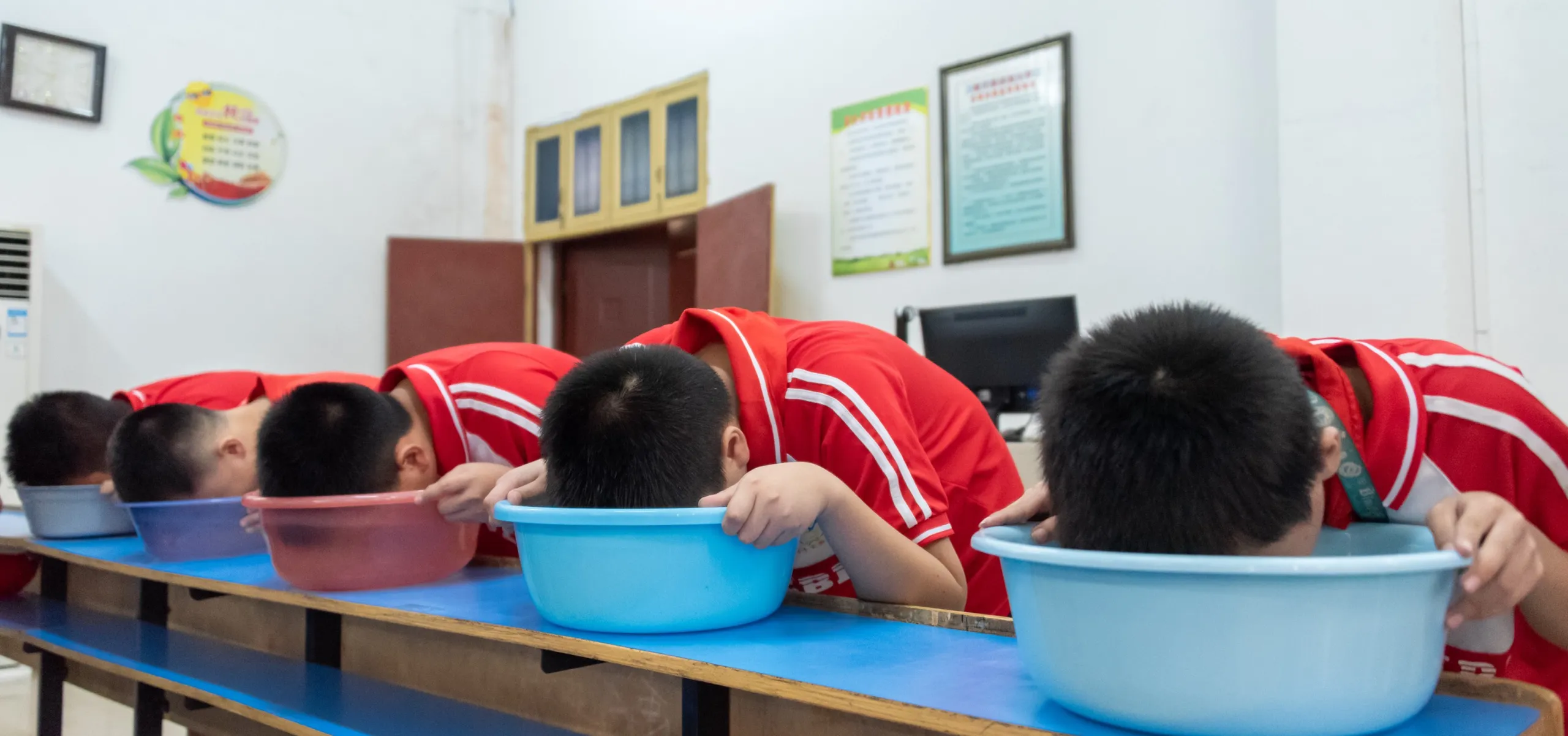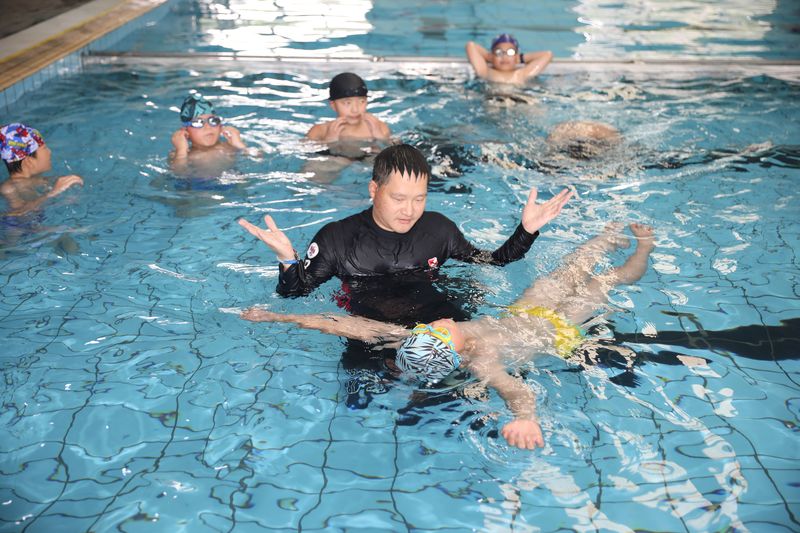Around 57,000 people die of drowning each year in China. What is the country doing to help?
In Hengshan county, Hunan province, dozens of children, clinging to the edge of the pool while lowering their faces into the water, are practicing holding their breath underwater as their teacher Tang Huan moves around to offer instruction and ensure their safety.
Having lost two students to drowning in 2020, the 32-year-old P.E. teacher spent over 10,000 yuan and three years building the 75-cubic-meter swimming pool, offering youngsters free swimming lessons in an attempt to prevent any further tragedies. Over the past three years, Tang has taught over 100 elementary school students how to swim.
Tang and others have felt compelled to act due to the alarming regularity of child drownings that occur every year in China. In fact, apart from traffic accidents, drowning has become the leading cause of death among elementary and secondary school students, according to a 2021 report from the Chinese Center for Disease Control and Prevention. Statistics from the National Health Commission and Ministry of Public Security show that a total of about 57,000 people die of drowning each year in China, more than a half of them under 14 years old. About 80 percent of the fatal accidents occur in wild open bodies of water, mostly during summer vacation in July and August.
This year has been no different. On June 20, a 16-year-old boy in Sichuan province jumped into a river to save his dog but was washed away and confirmed drowned after two days of search and rescue efforts. On July 31, six people in Qinghai province died after trying to save a child from drowning. On August 3, a couple in Guangxi took their son and daughter to play by a river, but both children fell into the water and only the 5-year-old boy was saved. On August 13, four children went to bathe in a river in Chongqing, and all perished after going in too deep.
More fatal drownings occur in rural areas, where there are more unregulated bodies of water and far fewer swimming pools than in the cities. Many victims are “left-behind” children (whose parents have gone to work in the city), Li Xingfu, an expert in drowning prevention education, told Jimu News in June this year. “Their desire to swim can only be fulfilled through rivers, lakes, and ponds as few swimming pools can be found in villages,” said Li.
As the elementary school where she teaches doesn’t have a pool, one rural teacher in Anhui who preferred to be identified as Wan Ya needs to take her students nearly one hour by bus to reach the nearest indoor swimming pool in the county.
In the early 20th century, as swimming pools and lessons were a rarity, people of all ages taught themselves by swimming in rivers and lakes. Mao Zedong even famously swam across the Yangtze River.
Though China won 18 gold medals at the 2022 World Aquatics Championships, few Chinese people know how to swim and drowning is tragically common across the country.
Official figures for the number of teenagers able to swim are hard to find, but a survey in a 2017 report from media outlet Huanqiu.com found that about 80 percent of students at elementary and secondary schools in the island province of Hainan couldn’t swim. Due to the lack of funding, space, and qualified teachers, only one secondary school in the province offered swimming classes.
To reduce the number of drownings, the government of Hainan released a swimming education program in 2017 and planned to teach all students at elementary and secondary schools to swim by 2020, building pools in cities and towns and making swimming lessons available in all schools. As of January 2022, over 200,000 students have undergone training and over 95 percent of them are able to swim 25 meters without assistance, according to a report from media outlet YNET.
As of 2021, there were 32,500 swimming pools in China, less than half of which are indoors. This equates to approximately one swimming pool for every 43,000 people, compared to one for every 33 people in the US, most of them concentrated in urban areas. .
Following Hainan, Jiangxi, Guizhou, and Yunnan provinces have included swimming in the curriculum of elementary and secondary schools as required courses to improve students’ fitness and reduce the number of drownings. Some communities have also chosen to build swimming pools locally. Xingguo county in Jiangxi declared in July this year that each village should build one swimming pool for children to give them a safe place to learn how to swim.
Grassroots efforts are also playing a role. Like teacher Tang, Shen Jianliang, a retired soldier from Fujian province, spent over 200,000 yuan building a pool in 2013. He opened it to local children for free, teaching them how to swim and serving as a lifeguard throughout the day. This summer, a Hunan farmer called Xiao Ming converted his fish pond into a swimming pool for local children, who are supervised by village officials, parents, and other volunteers as they swim.
Growing demand for swimming has seen water parks emerge as a popular alternative to indoor pools. However, the lack of regulatory oversight has had deadly consequences. On July 16, an inflatable pool at a water park in Pengxi town, Sichuan province collapsed, killing a student and causing nine injuries. A week before the tragedy, local residents had reported the water park to the provincial authorities over severe safety hazards including its missing business license, makeshift pools, and location beside a busy road.
To prevent drownings, schools are making efforts to educate students in various novel ways. In Zhoukou, Henan province, one elementary school is offering classes where students immerse their faces in a basin full of water to mimic the sensation of drowning, helping them to stay calm with their head underwater.
Taking more extreme measures, the city of Yibin, Sichuan, announced prizes of 100 to 200 yuan for anyone who stops elementary and secondary school students from playing in unregulated waters, whether swimming, rafting, or fishing. Students caught playing in these areas will be ineligible for honors and awards for the school year.
In 2004, the Ministry of Education released an emergency announcement that schools should provide swimming safety education to students to end the string of tragic drownings. Since then, every year the ministry has required schools to conduct safety education in various forms, including class meetings, home visits, and lectures. A 2022 report issued by the central government noted that all education sectors should include the prevention of student drownings in their work, with their performance then assessed by local government.
However, the pressure on teachers to prevent drownings is itself becoming an issue. This summer vacation, Wan sent three text messages each day to remind parents of the need to practice safe swimming. Exhausted, Wan feels misunderstood by several parents. “Are you going to annoy us every day? Can’t you teach our kids something, instead of wasting our time?” Wan recalls them replying to her. Many teachers shared similar complaints on Q&A platform Zhihu, including having to patrol the riverside in summer.
A secondary school teacher in Zhejiang province, who wanted to be identified by her surname Xue, tells TWOC she not only had to send notifications to parents, but also had to visit students’ homes during her summer vacation in July to remind their families of the importance of water safety. While Xue supports providing swimming education in schools, “shouldn’t we also consider the education from society and family?”
Yet for all the burdens and criticism they face, many teachers are keen to do their part in keeping their students safe. Tang looks forward to reopening his pool next May, so he can help students learn to swim and “let them play safe and sound.”















